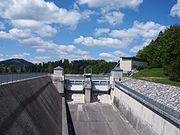Forggensee
| Forggensee | |
|---|---|
Ostallgäu | |
| Construction began | 1950–1954 |
| Dam and spillways | |
| Impounds | Lech, Füssener Ache, Mühlberger Ache |
| Height (foundation) | 41 m |
| Height (thalweg) | 37 m |
| Length | 320 m |
| Elevation at crest | 785 m above sea level (NHN) |
| Width (crest) | 10 m |
| Dam volume | 650,000 m3 |
| Reservoir | |
| Active capacity | 168 Mm3 |
| Catchment area | 1,594 km2 |
| Surface area | 15.2 km2 |
| Maximum length | 8.7 km |
| Maximum width | 2.8 km |
| Normal elevation | 780.5 m above sea level (NHN) |

The Forggensee, also called the Roßhaupten Reservoir, is a reservoir located north of
Origin
Following the climax of the
Lake Füssen
Even though the Forggensee is not a natural lake today, it is located in a basin that was filled by a much larger lake after the last ice age: when after the
North of the Lech Waterfall was one of these glacial lakes, Lake Füssen (Füssener See), a waterbody with an area of 60 km2 whose surface lay at a height of 790 m above NHN, which was formed as water levels rose behind the ridge (tectonically formed sediments of the molasse, which exhibit greater resistant to erosion than the rocks of the Cretaceous Flysch zone adjoining them to the south) at the southern end of the Murnau Depression at the northern end of the present-day Forggensee.
This lake may be viewed as the forerunner of the Forggensee and the smaller Pre-Alpine lakes in this region, most of which have survived. The foothills of the Alps were finally free of ice around 14,500 years ago.
Silting up of Lake Füssen
The resulting lake basins were filled with clay and silt deposits from glacial
Only small lakes in the hollows of the former lake bed have survived: the
Reservoir

The first plans for using the
In 1910, the "Royal Supreme Construction Authority" (Königliche Oberste Baubehörde) published a memorandum on the utilization of water power on the
The increasing demand for electricity in the interwar period aroused renewed interest in building a Lech storage reservoir. A draft paper from 1936/37 envisaged a storage target of 784 m above NHN, i.e. three meters higher than later, and a concrete dam with a built-in power plant.
In 1940, the Bavarian Hydropower Works (Bayerische Wasserkraftwerke or BAWAG) was founded to build hydropower stations on the Lech, the Lower Isar, and the Upper Danube. Due to the long construction period of the war years, the planned start of construction of the Roßhaupten Reservoir was postponed. Only the Lech levels 7 to 15 between Landsberg and Schongau could be built in the years 1940 to 1950 - the smaller plants could be built faster.
After the end of the
BAWAG, meanwhile only responsible for expanding the Lech dams, began building the Lech Reservoir in 1950. This led to strong protests from the residents, who founded a protective association and reached a largely satisfactory agreement with BAWAG in the 1952 Schwangau Agreement. For those affected, either new farms could be found nearby or new houses were built. Above all, many of the farmers and their descendants who lived in what is now the Forggensee area can still be found in the surrounding communities today. Construction of the dam began in early 1951 after new access roads and a residential camp for up to 1,000 workers had been built. To ensure the dam structure was watertight, the entire dam and its associated structures were built directly on rock; For geological reasons, this did not happen directly at the breakthrough of the Lech through the Illa's Gorge as originally planned, but about a kilometre downstream, so that the ecologically valuable gorge was lost in the process. On the lakeside, a five-meter-thick concrete apron was installed up to 20 meters deep into the rock. In the spring of 1952, the Lech was dammed here and diverted through a tunnel that had been built in the meantime. In the remaining two years until its completion at the end of 1954, the remaining structures were built and the dam was flooded. The building materials were largely obtained from the reservoir itself.

The Roßhaupten Dam was renovated in 2018, which is why the lake was not filled in 2018 (as it is every spring).[1] In 2019 the lake was reflooded.[2]
Conservation and archaeology
Altogether 32 residential buildings with 256 inhabitants (1950)
The former episcopal mill, which was moved from Waltenhofen to Forggen in 1644, was probably the most important building among the larger individual farms; today its foundation walls are crumbling on the lake bed.
At the northern end of the lake, the Dösinger local researcher Sigulf Guggenmos (1941–2018) discovered various important archaeological sites, including traces of Mesolithic hunting stations and a Late Celtic or Roman place of sacrifice.[4]
A few hundred metres from today's shore, on the former path from Brunnen to Forggen, you will come across the foundation walls and brick remains of a Roman
, which was used seasonally.Recreation
The lake provides ideal conditions for surfing, sailing, fishing, and boating. The lake is stocked with pike, trout and eel. Two ships navigate the lake on two different routes.
Gallery
References
- ^ Christian Rost (2018-04-30). "Der Forggensee bleibt diesen Sommer trocken". Süddeutsche Zeitung. Retrieved 2018-05-26.
- ^ "Projekt Staudamm Roßhaupten – Informationen zur Erneuerung der Dammdichtung". Uniper. 2019-04-02. Retrieved 2019-04-30.
- ^ Official Settlement Register for Bavaria, based on the census of 13 September 1950, Munich, 1952, column 1288
- ^ Armin Guggenmos, Birgit Gehlen (January 2019), "Nachruf S Guggenmos BA", Bayerische Archäologie (in German), retrieved 2019-10-30
External links
 Media related to Forggensee at Wikimedia Commons
Media related to Forggensee at Wikimedia Commons- Forggensee, lakes in Füssen











